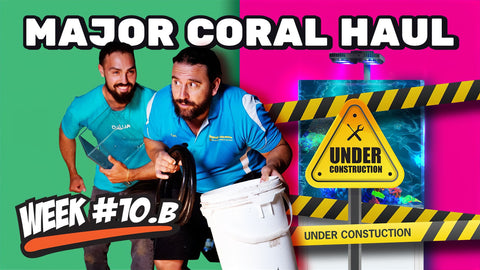Best Equipment To Start A Reef Tank | 12 Week Reef Video Tutorial #3
Starting a Reef Tank: Planning, Filtration, and Plumbing Essentials
If you're starting a reef tank, understanding the right equipment. Saltwater aquarium filtration systems, and plumbing setup is crucial. This post will guide you through the basics of setting up a life support system for your saltwater aquarium, with a focus on filtration methods and plumbing essentials.
Filtration for a Reef Tank: A Closer Look
Before getting into the technical aspects of plumbing, let’s focus on filtration—the heart of any thriving saltwater aquarium. Filtration helps maintain water quality, ensuring your corals and fish stay healthy.
1. Mechanical Filtration
Mechanical filtration works by forcing water through filter socks, filter wool, or even a roller mat, removing larger debris from the water. This is crucial for maintaining water clarity and removing pollutants before they break down into harmful nutrients.
2. Chemical Filtration
Chemical filtration involves the use of materials like activated carbon to remove toxins, excess organics, and even heavy metals from your aquarium. In reef tanks, managing phosphates and nitrates is essential for maintaining water chemistry. Products like GFO (Granular Ferric Oxide) help control phosphate levels, which we’ll discuss further in future posts.
3. Biological Filtration
Biological filtration uses beneficial bacteria to break down waste in the nitrogen cycle. It’s all about maximizing surface area for bacteria to colonize. Popular choices include:
- Bio blocks: These are small, porous blocks offering massive surface areas for beneficial bacteria.
- Marco rocks and sand: These natural materials provide large amounts of surface area for biological filtration, making them ideal for reef tanks. Having ample biological filtration is key to managing waste and keeping your water clean.
Plumbing a Reef Tank: What You Need to Know
Once you've nailed down your filtration, it's time to focus on plumbing. Proper plumbing is essential to maintain the flow of water between your tank and the filtration systems housed in the sump.
Understanding the Sump: The Life Support of Your Tank
A sump is where your reef tank’s life support system is housed, including all the filtration and heating components. Here’s how it works:
- Overflow and Mechanical Filtration: Water from the display tank flows through an overflow system, where larger debris is captured by filter socks or roller mats.
- Biological and Chemical Filtration: After mechanical filtration, water moves to chambers containing your biological media and carbon, taking care of nutrient control and water quality.
- Protein skimmer: This essential piece of equipment removes dissolved organic waste, ensuring your water remains nutrient-free. A protein skimmer is a must for any reef tank.
- Heaters: Install two heaters in your sump as a fail-safe measure to keep the water at the right temperature. If one fails, the other will maintain stability.
- Return pump: Water is then pushed back up to the main display by the return pump, creating a continuous cycle of filtration.
Protein Skimmer and Pumps for Reef Tanks
The return pump is essential in reef tanks, as it pushes water from the sump back into the display tank, creating vital circulation. Without proper water flow, nutrients and waste wouldn’t be adequately filtered, putting your corals and fish at risk. When planning the plumbing for your reef tank, consider installing a manifold system. This will allow you to easily direct water flow to additional equipment, such as a chiller (to cool the water in warmer months) or a UV sterilizer, which can help maintain water cleanliness and prevent parasites.
Setting Up the Wavemaker: Circulation is Critical
One of the most important pieces of technology in a reef tank is the wavemaker, which replicates the natural flow of ocean water. This constant movement helps deliver nutrients to your corals, prevents dead spots, and encourages healthy water circulation. For anyone starting a reef tank, investing in a good wavemaker is absolutely critical. Flow is life!
Plumbing Like a Pro: Getting it Right
When it comes to plumbing your reef tank, remember: every tank is different. While most modern aquarium systems come with a set of pipes and fittings that require minimal effort to assemble, it’s important to follow the manufacturer’s instructions carefully. Here are a few things to keep in mind:
- Water flow: Make sure you have sufficient flow from your return pump to ensure even circulation throughout the tank. Aim for 3 to 7 times aquarium volume turn over per hour.
- Leak prevention: Pay close attention to O-rings and other connections to prevent leaks.
- Noise reduction: Proper fittings and valves can help minimize noise from water flow. Most modern reef tank setups are plug-and-play, meaning no gluing is required for leak-free plumbing. However, it's always a good idea to check that all components are installed correctly.
Saltwater Aquarium Best Start Guide
In the coming weeks, we’ll dive into topics like:





